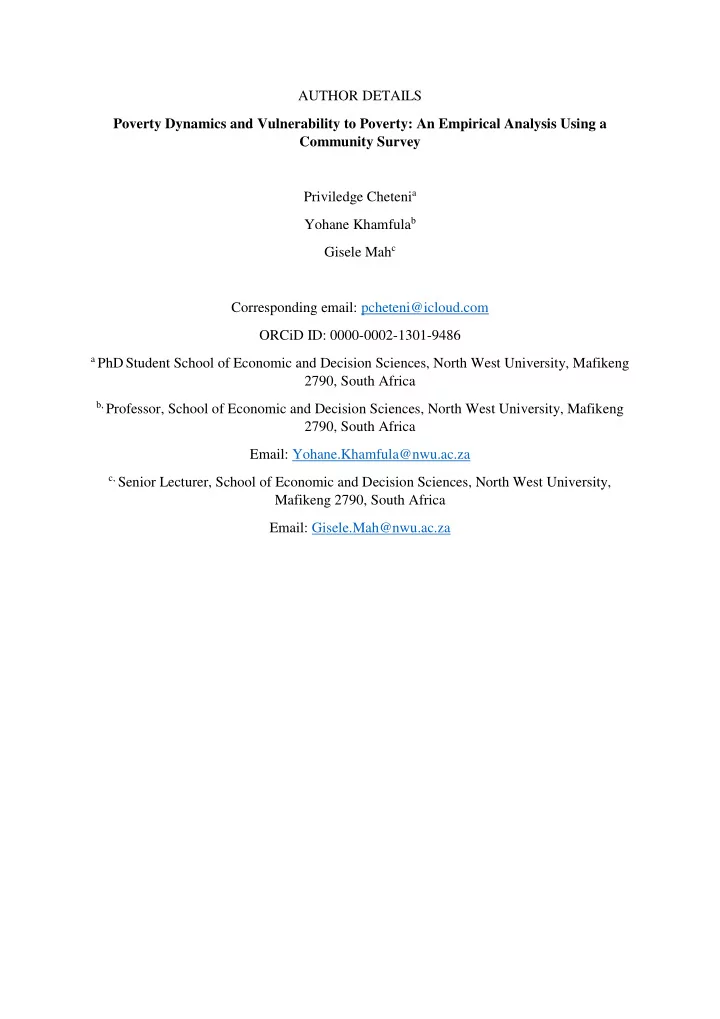

AUTHOR DETAILS Poverty Dynamics and Vulnerability to Poverty: An Empirical Analysis Using a Community Survey Priviledge Cheteni a Yohane Khamfula b Gisele Mah c Corresponding email: pcheteni@icloud.com ORCiD ID: 0000-0002-1301-9486 a PhD Student School of Economic and Decision Sciences, North West University, Mafikeng 2790, South Africa b, Professor, School of Economic and Decision Sciences, North West University, Mafikeng 2790, South Africa Email: Yohane.Khamfula@nwu.ac.za c, Senior Lecturer, School of Economic and Decision Sciences, North West University, Mafikeng 2790, South Africa Email: Gisele.Mah@nwu.ac.za
Poverty Dynamics and Vulnerability to Poverty: An Empirical Analysis Using a Community Survey ABSTRACT This article explores vulnerable to poverty and poverty dynamics in South Africa. Utilising panel data from 2012 to 2015, we estimate the likely determinants of household vulnerability using a multinomial logit model. We then decompose the FGT poverty index by groups and income components using the Shapley Value to identify household vulnerability status. Our analysis reveals that black Africans residing in tribal or traditional areas are the most exposed to vulnerability and poverty. In addition, their likelihood of escaping poverty is minimum. High-income variability contributes to vulnerability and poverty among urban and rural areas. Additionally, we demonstrate that only a few households fall in the middle (lower bound) poverty lines. Race and location are strong predictors of poverty in South Africa. These findings have an important implication in the design of poverty policies. Therefore, there is a need for the government to design customised policies that are race and location sensitive, as opposed to a blanket approach. Keywords: Income distribution, Inequality, Multinomial logit model, Principal Component, sub-Sahara JEL Classification C21 C61 I32 O10 R20
1. INTRODUCTION During the past decade, South Africa has faced numerous challenges including unpredictable fuel prices, volatile exchange rate, severe weather events and recently the downgrading of the economy to a junk status. However, the lack of longitudinal data has led to a neglect in studies focusing on vulnerability and poverty dynamics. Studies conducted by Vakis et al., (2015) and Ferreira et al., (2013) focused on intra generational mobility on the middle class and chronic poor in south Africa, and found that, the middle class had a low probability of experiencing poverty. Empirical studies have proven that poverty is sometimes generational driven, and in certain instances, an outcome of vulnerability. In general, vulnerability refers to the exposure of individuals or households to contingencies and stress and their difficulties in coping with them. According to Chambers (1989), vulnerability is both internal and external, were the external side refers to risks, stress and shocks to which an individual is subjected to, and the internal side refers to the lack of means to cope with the vulnerability. Risks vary in nature and range from macro-economic shocks, hazards and natural disasters. In economics, vulnerability is an outcome of a process of households’ responses to risks given a set of underlying conditions (Alwang, Siegel & Jorgensen, 2001). Consequently, vulnerable households are the ones who are likely to fall into poverty because of cumulative risks and responses. The poor are the most vulnerable because of t heir location and exposure to risky events such as natural disasters, economic disturbances to name a few (Sharma et al, 2000). Devereux (1999) and Sharma et al, (2000) found that the poor has less access to assets that can be used to manage risk through their responses. Therefore, the poor tend to be disfranchised and their ability to managed risk is compromised (Narayan et al. 2000). In support of this view, Winters et al (2004) reiterate that vulnerability is a key element of poverty and a major concern, although the authors admit that the two are not coterminous. Poverty is seen as demonstrating a wellbeing status; yet, vulnerability is said to be stochastic and dynamic (Winters et el, 2004). Pritchett, Suryhadi and Sumarto (2000) define vulnerability as the probability of being below the poverty line in a three-year period. On the other hand, vulnerability can then be said to be a measure of wellbeing, reflecting the likely future prospects of a household (Chaudhuri, 2003). Broadly, risk can come from covariate shocks or idiosyncratic shocks. Household specific shocks can be a death in the family of an income earner, unhygienic living conditions or any unfavourable household situation. Yet, covariate shocks are community level shocks such as natural disasters like cyclone, floods, drought to name a few. All these have a potential to contribute to volatility in a household income. Therefore, we can view vulnerability as a product of poverty, which exposes household abilities to cope with risks. As stated by Carter and Barrett (2006), household can be in persistent poverty due to risks. Thus, an understanding of how households should cope with such risk is an important step in poverty reduction efforts. Ajay and Rana (2005) point that knowing the characteristics of movements in and out of poverty can help policy makers. Household vulnerability is said to be in four ways namely; changes in income, changes in household portfolio activities, poverty traps and changes in variability of existing income. According to Reardon (1997), household have a variety of sources of income, as a result, a household maximises a portfolio which increases its utility by taking into account the degree of the risk aversion (Ellis, 1993). Thus, any changes in their portfolio arrangements have a likelihood of increasing their vulnerability to poverty. Similarly, income variability can pose a challenge to struggling households by exposing them to shocks both endogenous and
Recommend
More recommend